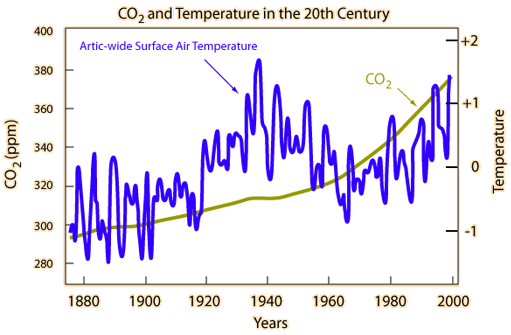Is CO2 sufficient to drive global warming?
The CO2 in the atmosphere of Venus plus the absence of water vapor (the most important greenhouse gas) is responsible for the runaway greenhouse effect that has made Venus an uninhabitable oven. The surface temperature of Venus is about 480°C or 900 °F.
But the Earth's atmosphere has plenty of water vapor, and even without it the atmosphere is dominated by nitrogen and oxygen.
| | ||
| Component | Percentage | Partial pressure(mmHg) |
| Nitrogen | | |
| Oxygen | | |
| Argon | | |
| Carbon dioxide | | |
It does seem extraordinary that after a long period of relatively stable planetary climate the increase in CO2 from 0.027% to 0.038% should suddenly unbalance the climate of the planet.

The temperature variations of the 20th century do not in fact track the CO2 concentration well at all. The above illustration is a sketch of data presented by Durkin and is subject to comparison with more primary references. It could be argued that we have just gotten into the area where the radiative forcing of the greenhouse gases show the human influence since about 1970. But overall for the 20th century, it appears that solar activity correlates more closely with temperature change.
Even limiting the claims of CO2 driving to the period past 1970 leaves room for a number of skeptics. One of the skeptics is Richard S. Lindzen, Professor of Meteorology, MIT, who is doubtful of the reliability of the climate modeling that suggests large temperature changes from the CO2. In his testimony before the U.S. Senate Environment and Public Works Committee in 2001: "doubling CO2 alone will only lead to about a 2F increase in global mean temperature. Predictions of greater warming due to doubling CO2 are based on positive feedbacks from poorly handled water vapor and clouds (the atmosphere’s main greenhouse substances) in current computer models. Such positive feedbacks have neither empirical nor theoretical foundations. Their existence, however, suggests a poorly designed earth which responds to perturbations by making things worse."
 | The illustrations at left show the climate models with natural, anthropogenic (human origin), and combined effects. They are essentially those available from the IPCC sources, but this particular presentation of them is from Chris Merchant, School of GeoSciences, University of Edinburgh . Merchant points out that the CO2 greenhouse effect is an important contributer to the energy balance of the Earth, even though its concentration is small. Models suggest that without the CO2 in the atmosphere, the Earth might be around 30 degrees cooler. Conceding that human contributions to the atmospheric CO2 are only about 2%, with the remainder coming from natural sources including the sea, that 2% has been contributed independently of the natural balancing of CO2 that kept it about constant for hundreds of years prior to the industiral age. The CO2 data show an increase from 315 to 380 ppm since 1958 after concentrations in the high 200's for a long period before the 20th century. |
| Skeptical views of CO2 driven global warming |
References
Collins, et al.
Durkin
| HyperPhysics***** Thermodynamics | R Nave |